|
Self-Teaching Unit:
Major Comma Uses
© 2005, 2002, 1987 Margaret L.
Benner All rights reserved.
COMMA
RULE #1 – THE COMMA IN A SERIES:
Use commas to separate items in a series.
What is a ”series”?
A “series” is a list of 3 or more items, the last two of which are
joined by and,
or,
or nor.
_____________, ______________,
and _____________
EXAMPLES:
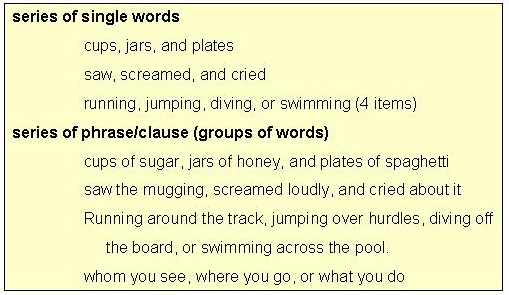
Any of these can be put into sentence
form.
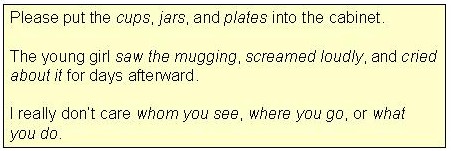
The important things to remember about
using commas in series are these:
1.
A series includes 3 or more items of the same type (words or groups of
words).
2.
The series is connected by and, or, or nor
before the last item.
3.
A comma separates items in the series, including the final item preceded
by and, or,
or nor.
Now click on the link below to do exercise
1.
Link to Exercise 1
COMMA
RULE #2 – THE COMMA WITH COORDINATE ADJECTIVES:
Use commas between coordinate adjectives.
What are
“coordinate adjectives”?
“Coordinate adjectives” are adjectives placed next
to each other that are equal in importance.
Two
tests to determine whether adjectives are coordinate are the following:
1.
See whether “and” can be smoothly placed between them.
2.
See whether the adjectives’ order can be reversed.
Look at this example.

In this example, a comma belongs between
happy
and lively
because they are coordinate adjectives.
Test to make certain:
First, try the “and” test.

And
placed between the 2
adjectives sounds smooth.
Second, try reversing the
adjectives.

When the adjectives are reversed, the sentence still makes sense.
Thus,
happy
and lively are coordinate adjectives in the example and should be
separated by a comma.

CAUTION: Not all adjective pairs are
coordinate adjectives. Thus, not
all adjectives should be separated from one another by a comma.
Look at this example.

In this example, no comma belongs
between the two adjectives young
and golden
because they are not coordinate adjectives.
How can we know?
First, try the “and” test.

And placed between the two
adjectives does not fit smoothly.
Second, try reversing the
adjectives.

When the two adjectives are reversed, they do not make sense.
Thus,
young
and golden
are not coordinate adjectives and should not be separated by a comma.

Now click on the link below to do exercise
2.
Link to Exercise 2
COMMA RULE #3 – THE COMMA IN A
COMPOUND SENTENCE: Use a comma before and, but, or, nor, for, so, or yet to join two
independent clauses that form a compound sentence.
What is a compound sentence?
A compound
sentence is a sentence that has 2 independent clauses.
An independent
clause is a group of words with a subject and verb that expresses
a complete
thought. It is also known as a simple sentence.
An independent clause can stand alone as a sentence.
The two independent clauses in a
compound sentence can be joined by:
A. Semicolons

OR

B. A comma and one of the seven joining words: for,
and, nor, but, or, yet, and so.
(Taken together, the first letters spell “FANBOYS.”)

This last type of compound sentence is
the one we will concentrate on for comma use.
A compound sentence must have two
independent clauses – not just two verbs, two nouns, or two groups of words
that are not independent clauses.
Look at this example.

In the above example, two verb groups
are being joined by and.
The second verb group does NOT
have a subject; thus, it is NOT an
independent clause.
Therefore, NO
comma belongs before and.
This example is a simple
sentence with a compound
verb, not a compound sentence.
However, we can make this sentence into
a compound sentence by simply making the last verb part into an independent
clause.

Now we have a “bona fide” compound
sentence. The two independent
clauses are separated by a comma and the word and.
Here are some other examples which
illustrate the difference between compound elements in simple sentences (no
comma) and true compound sentences (comma).
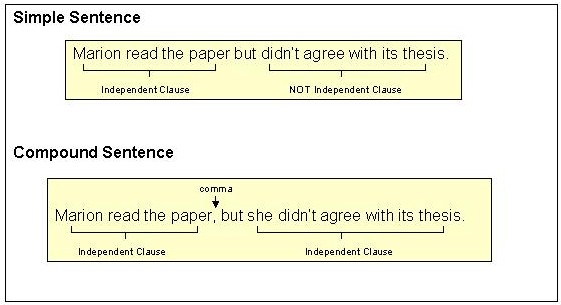
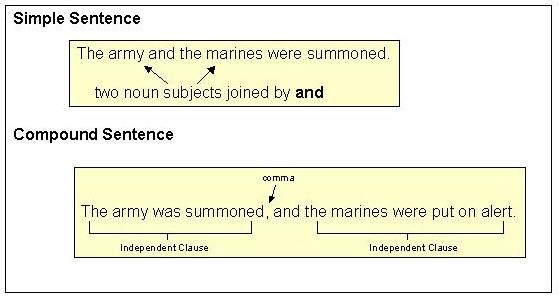
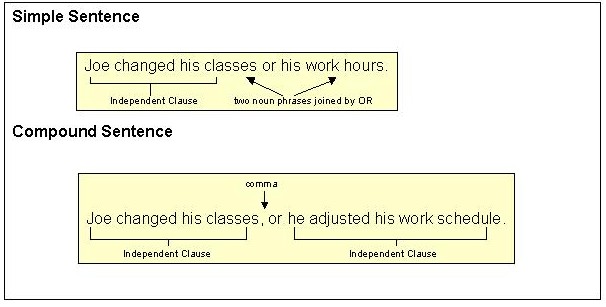
Now you are ready to try an exercise.
Make certain that you:
1. Know the seven joining
words (for,
and, nor,
but, or, yet,
so).
2. Can
distinguish between simple sentences with compound elements (no comma) and
compound sentences (comma).
Now click on the link below to do exercise
3.
LINK TO EXERCISE 3
COMMA RULE #4 – THE COMMA WITH
INTRODUCTORY WORDS: Place a comma after
introductory phrases that tell where, when,
why,
or
how.
Specifically
. . . use a comma:
1.
After a long introductory phrase.
Example:

Usually, it is NOT necessary to use a
comma after short introductory prepositional phrases.
Example:

2.
After an introductory phrase made up of “to” plus a verb and any
modifiers (“infinitive”) that tells why.
Example:

Use a comma even after a short
“to” + verb phrase that answers why.
Example:

You can tell you have this kind of
introductory “to” + verb phrase when you can put the words “in order” in
front of the phrase.
Example:

Be careful!
Not all introductory “to” phrases tell why.

3.
After an introductory clause that answers
when? where?
why?
how?
to what degree?
(A “clause” is a group of words with
a subject and a verb.)
Examples:
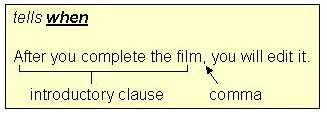
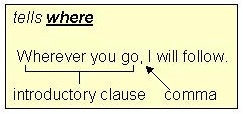
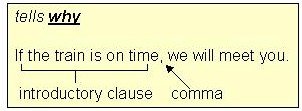

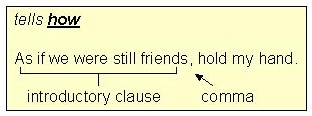
NOTE: When such a clause comes at the end of a sentence, do NOT
use a comma.
Examples:


Now click on the link below to do exercise
4.
Link to Exercise 4
COMMA RULE #5 – THE COMMA WITH
NONESSENTIAL WORDS, PHRASES, AND CLAUSES: Separate
with a comma any nonessential words or groups of words from the rest of the
sentence.
1.
Separate “interrupter” words like however,
nevertheless, yes, no,
of course, from the rest of the
sentence.
Examples:


2.
Separate a “renamer” (an
appositive) from the rest of the sentence with a comma.
Example:

3.
Separate adjective phrases from the essential parts of the sentence.
(An “adjective” describes or limits a noun.)
Examples:




In each instance above, “Mary Roberts
ran down the street” comprises the essential part of the sentence. The adjective phrases are nonessential
and should be separated from the rest of the sentence with commas.
4.
Separate nonessential adjective clauses from the rest of the sentence.
There are two
kinds of adjective clauses:
- one that is needed for the sentence to be
complete (ESSENTIAL)
- one that is NOT needed for the sentence to be
complete (NONESSENTIAL)
The essential
adjective clause should NOT be separated from the sentence with commas.
The nonessential
adjective clause (like other nonessential elements) SHOULD be separated with
commas.
Two examples illustrate the difference:
A.

B.

Look at example A.
If we remove the adjective clause “who robbed the bank,” the sentence
reads, “The man was caught today.” Without
the adjective clause (“who robbed the bank”), we do not know which
man was caught. Thus, the adjective
clause is needed to complete the sentence’s meaning.
In other words, this adjective clause is essential. As the rule notes, do not use commas around essential
adjective clauses.
Now look at example B.
If we remove the adjective clause “who robbed the bank,” the sentence
reads, “Sam Spider was caught today.” Without
the adjective clause (“who robbed a bank”), we do
know which man was caught (Sam Spider). Thus,
the adjective clause is NOT needed to complete the sentence’s meaning.
In other words, this clause is nonessential.
Following the rule, you should separate this adjective clause from the
rest of the sentence.

REMEMBER, there are 4 nonessential
elements that should be separated from the rest of the sentence with commas:
1.
“interrupter” words like of
course, however
2.
“renamers” (appositives)
3.
nonessential adjective phrases
4.
nonessential adjective clauses
Now click on the link below to do exercise
5.
Link to Exercise 5
Now click on the link below to do the post test.
Link to the Post Test
|